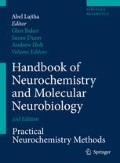Abstract:
Neuroscientists may wish to quantify an enzyme activity for one of many reasons. In order to do so, the researcher must be able to set up an assay appropriately, and this requires some understanding of the kinetic behavior of the enzyme toward the substrate used. Furthermore, such an understanding is vital if the inhibitory effects of a drug are to be assessed appropriately. This chapter outlines key principles that must be adhered to, and describes basic approaches by which rather complex kinetic data might be obtained, in order that enzyme kinetics and inhibitor kinetics might be studied successfully by the nonexpert.
Access this chapter
Tax calculation will be finalised at checkout
Purchases are for personal use only
References
Cleland WW. 1963a. The kinetics of enzyme‐catalyzed reactions with two or more substrates or products. I. Nomenclature and rate equations. Biochim Biophys Acta 67: 104.
Cleland WW. 1963b. The kinetics of enzyme‐catalyzed reactions with two or more substrates or products. II. Inhibition: nomenclature and theory. Biochim Biophys Acta 67: 173.
Cleland WW. 1963c. The kinetics of enzyme‐catalyzed reactions with two or more substrates or products. III. Prediction of initial velocity and inhibition patterns by inspection. Biochim Biophys Acta 67: 188.
Dixon M. 1972. The graphical determination of K M and K I. Biochem J 129: 197.
Green AL. 1984. Assessment of the potency of reversible MAO inhibitors in vivo. Monoamine oxidase and disease. Tipton KF, et al editors. London: Academic; pp. 73–81.
Henderson PJ. 1972. A linear equation that describes the steady‐state kinetics of enzymes and subcellular particles interacting with tightly bound inhibitors. Biochem J 127: 321.
Henderson PJF. 1993. Statistical analysis of enzyme kinetic data. Enzyme assays. A practical approach. Eisenthal R, Danson MJ, editors. Oxford: Oxford University Press; pp. 277–316.
Holt A, Wieland B, Baker GB. 2004. Allosteric modulation of semicarbazide‐sensitive amine oxidase activities in vitro by imidazoline receptor ligands. Br J Pharmacol 143: 495.
John RA. 1993. Photometric assays. Enzyme assays. A practical approach. Eisenthal R, Danson MJ, editors. Oxford: Oxford University Press; pp. 59–92.
King EL, Altman C. 1956. A schematic method of deriving the rate laws for enzyme‐catalyzed reactions. J Phys Chem 60: 1375.
Kitz R, Wilson IB. 1962. Esters of methanesulfonic acid as irreversible inhibitors of acetylcholinesterase. J Biol Chem 237: 3245.
Klinman JP. 2003. The multi‐functional topa‐quinone copper amine oxidases. Biochim Biophys Acta 1647: 131.
Lippert B, Metcalf BW, Jung MJ, Casara P. 1977. 4‐amino‐hex‐5‐enoic acid, a selective catalytic inhibitor of 4‐aminobutyric‐acid aminotransferase in mammalian brain. Eur J Biochem 74: 441.
Margoliash E, Novogrodsky A, Schejter A. 1960. Irreversible reaction of 3‐amino1:2:4‐triazole and related inhibitors with the protein of catalase. Biochem J 74: 339.
Monod J, Wyman J, Changeux J‐P. 1965. On the nature of allosteric transitions: a plausible model. J Mol Biol 12: 88.
Morrison JF. 1982. The slow‐binding and slow, tight‐binding inhibition of enzyme‐catalysed reactions. Trends Biochem Sci 7: 102.
Morrison JF, Stone SR. 1985. Approaches to the study and analysis of the inhibition of enzymes by slow‐ and tight‐binding inhibitors. Comments Mol Cell Biophys 2: 347.
Morrison JF, Walsh CT. 1988. The behavior and significance of slow‐binding enzyme inhibitors. Adv Enzymol Relat Areas Mol Biol 61: 201.
Motulsky HJ, Christopoulos A. 2003. Fitting models to biological data using linear and nonlinear regression. A practical guide to curve fitting. San Diego: GraphPad Software Inc.
Nimmo IA, Mabood SF. 1979. The nature of the random experimental error encountered when acetylcholine hydrolase and alcohol dehydrogenase are assayed. Anal Biochem 94: 265.
Oldham KG. 1993. Radiometric assays. Enzyme assays. A practical approach. Eisenthal R, Danson MJ, editors. Oxford: Oxford University Press; pp. 93–122.
Price NC, Stevens L. 1999. Fundamentals of Enzymology. New York: Oxford University Press.
Sculley MJ, Morrison JF. 1986. The determination of kinetic constants governing the slow, tight‐binding inhibition of enzyme‐catalysed reactions. Biochim Biophys Acta 874: 44.
Segel IH. 1993. Enzyme kinetics. Behavior and analysis of rapid equilibrium and steady‐state enzyme systems. New York: Wiley.
Shou M, Lin Y, Lu P, Tang C, Mei Q, et al 2001. Enzyme kinetics of cytochrome P450‐mediated reactions. Curr Drug Metab 2: 17.
Silverman RB. 1995. Mechanism‐based enzyme inactivators. Methods Enzymol 249: 240.
Storer AC, Darlison MG, Cornish‐Bowden A. 1975. The nature of experimental error in enzyme kinetic measurements. Biochem J 151: 361.
Syed SEH. 1993. High performance liquid chromatographic assays. Enzyme assays. A practical approach. Eisenthal R, Danson MJ, editors. Oxford: Oxford University Press; pp. 123–166.
Terstappen GC, Reggiani A. 2001. In silico research in drug discovery. Trends Pharmacol Sci 22: 23.
Acknowledgments
Work in the author's laboratory is supported by the Canadian Institutes of Health Research (CIHR), the Faculty of Medicine and Dentistry of the University of Alberta, the Northern Alberta Clinical Trial and Research Centre, and BioTie Therapies Corp. (Turku, Finland).
Editor information
Editors and Affiliations
Rights and permissions
Copyright information
© 2007 Springer Science+Business Media, LLC
About this entry
Cite this entry
Holt, A. (2007). Practical Enzymology. In: Lajtha, A., Baker, G., Dunn, S., Holt, A. (eds) Handbook of Neurochemistry and Molecular Neurobiology. Springer, New York, NY. https://doi.org/10.1007/978-0-387-30401-4_4
Download citation
DOI: https://doi.org/10.1007/978-0-387-30401-4_4
Published:
Publisher Name: Springer, New York, NY
Print ISBN: 978-0-387-30359-8
Online ISBN: 978-0-387-30401-4
eBook Packages: Biomedical and Life SciencesReference Module Biomedical and Life Sciences

